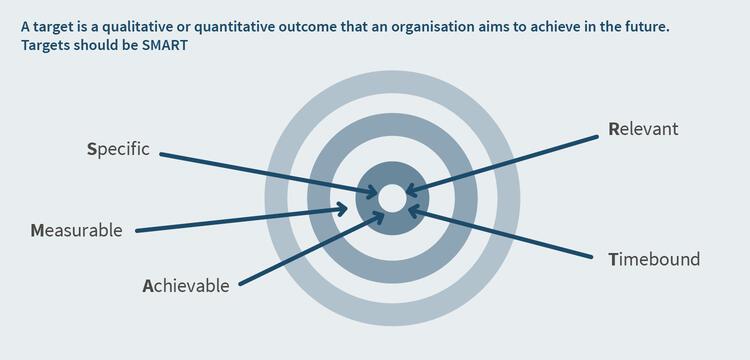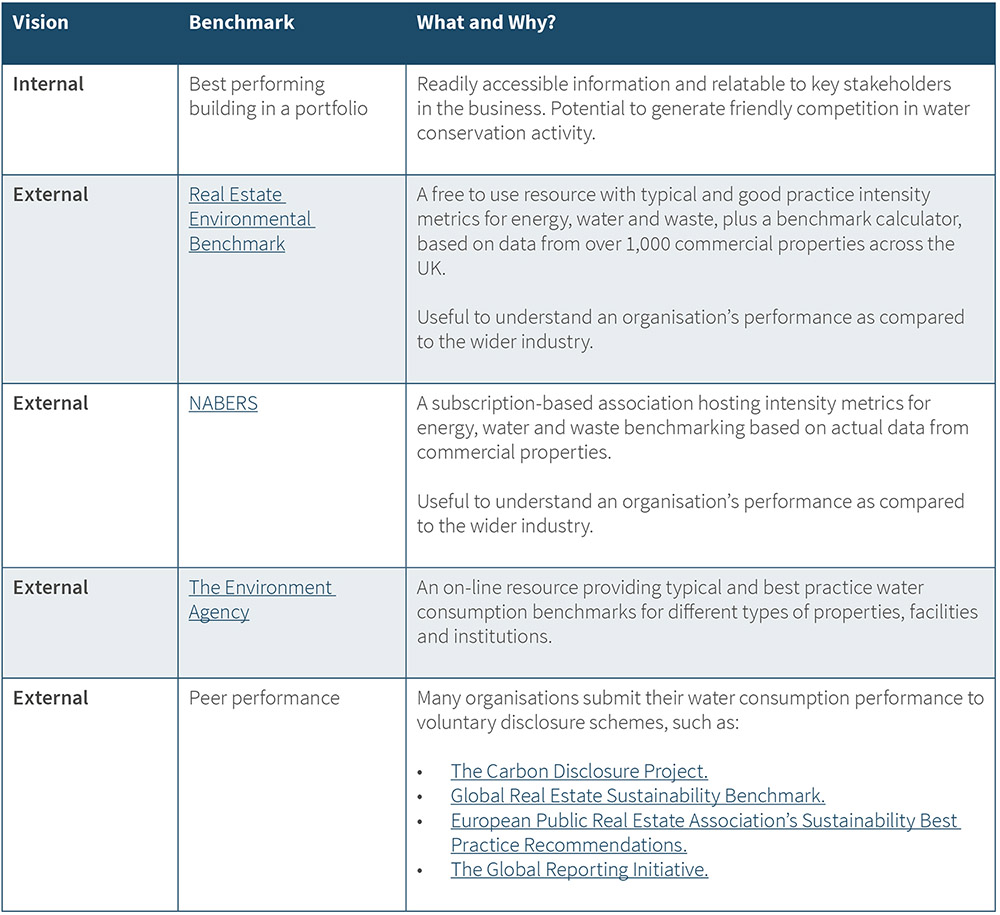GN 5.3: Benchmarking water use and setting targets
Guidance Note purpose
The purpose of this Guidance Note is to provide asset managers, property managers and facilities managers with information relating to benchmarking water usage and setting water saving targets within commercial properties.
Context
The real estate sector continues to make progress in resource efficiency. Like any area of performance management, establishing benchmarks and monitoring targets can demonstrate that practical actions are succeeding in conserving water, and that organisations are making progress towards their resource efficiency commitments.
It is important to distinguish between a benchmark and a target.
A benchmark is a point of reference which acts as a comparison to something similar.

A target is a qualitative or quantitative outcome that an organisation aims to achieve in the future. Targets should be ‘SMART’: Specific, Measurable, Achievable, Relevant and Timebound.
Importance
Every day, water companies provide around 14,000 million litres of water for public water supply. The Environment Agency has warned that around 3,435 million extra litres of water could be required each day, if no action is taken to improve the efficiency of water usage between 2025 and 20501. (is this in the UK?)
Inefficient water consumption causes damage to the ecosystem, through unnecessarily high rates of water abstraction, and represents a waste of financial and energy resources in treating water to be fit for use.
Setting targets and using various benchmarking tools to compare performance against peers and good practice standards can help improve processes, services and products. Ultimately, this will help identify processes to reduce water use and cut costs.
Targets are important as they enable performance to be monitored and can help to align a company’s focus with statutory requirements.
Benchmarks provide a useful tool which can help to ascertain:
- A company’s performance versus peers, or industry standards.
- A property’s performance against a similar type, or portfolio.
In turn, the understanding provided by benchmarking can inform the level of ambition and corresponding targets.
Water targets are also a core component of a submission of voluntary disclosure schemes. For all participants in these schemes, disclosure of water performance offers an opportunity to benchmark wider sustainability performance against peers, and the potential to enhance their brand, if performance is favourable.
For stock-exchange listed companies, which are often included in environmental and social governance exchange traded funds, participation in voluntary disclosure schemes creates an additional financial incentive.
Responsibilities & Interests
The table below summarises the key activities associated with benchmarking and setting water targets, and highlights where asset managers, property managers and facilities managers are likely to have a responsibility or specific interest.
- AM - Asset Manager
- PM - Property Manager
- FM - Facilities Manager
Benchmarking: 1- Collate water consumption data
Stakeholder:
Benchmarking: 2 - Normalise benchmarking data
Stakeholder:
Benchmarking: 3 - Consider appropriate benchmarks
Stakeholder:
Setting targets: 1 - Consider external and internal drivers
Stakeholder:
Setting targets: 2 - Consider boundaries and normalisation
Stakeholder:
Setting targets: 3 - Collaborate with occupiers
Stakeholder:
How to
Intro
Usually, the decision to participate in a benchmarking scheme, or to set property or portfolio water targets, is taken by an asset manager. The process of collating information that will inform this decision is coordinated by the property manager with input from the facilities manager.
Key considerations for benchmarking and setting energy targets are described below:
1. Collate water consumption data
Benchmarking
Water consumption data can be collected from invoices, incoming water meters, or submeters connected to data collecting platforms.
- Smaller properties may receive invoices on a quarterly basis with estimated reads, which means these might not be the most reliable when starting the data collection processes.
- Larger properties may receive invoices on a monthly basis, but readings might still be estimated.
Obtaining the most reliant water consumption data involves taking regular readings from the incoming meters or reviewing output from automated data collection platform.
2. Normalise benchmarking data
Before proceeding with a benchmarking exercise, it is important to normalise water benchmarking data, where possible. Unlike an absolute benchmark, a normalised water benchmark facilitates a like-for-like comparison with other properties or portfolios.
Normalisation can be delivered via a range of metrics, including, for example:
Annual water use in cubic meters (m3):
- Per employee.
- Per m2 of occupied space.
- Per tonne/litre of product.
- Per m3 of product.
3. Consider an appropriate benchmark
It is important that a benchmark aligns with a property or portfolio’s business strategy. There are a number of benchmarks which cover water consumption. These include, for example:
The following are all useful benchmarking options that could be considered:

Target setting: 1 - Consider external and internal drivers
It is also important to consider how a water target is set based on what is possible within strategic, budgetary and infrastructural constraints. This includes understanding what action and investment would be required to achieve the target, and considering the extent to which this resource, and the required actions, are achievable.
Understanding the water consumption profile of a property or portfolio, and the potential contribution that may be available through different energy saving opportunities, can inform a decarbonisation pathway and incremental targets within it.
Ideally, a target should combine both external and internal drivers.
- Short to medium-term targets based on known opportunities.
- Long-term targets recognising the potential for product and service innovation that may yet involve unknown quantities, or wholesale strategic change that offer energy and carbon reduction opportunities which are not immediately available.
2. Consider boundaries and normalisation
Water consumption targets should always be applied within a defined boundary. For example, organisations may decide to take:
- A whole portfolio approach, but should recognise that acquisitions and divestments may impact on performance and hence the ability to meet those targets.
- A like-for-like approach, where performance is normalised to account for acquisitions and divestments, by adding or removing associated consumption to a baseline.
- A steady state buildings approach, so that vacant buildings and those where building controls aren’t fully understood or employed, represent a more consistent approach to water consumption performance and target setting.
3. Collaborate with occupiers
Collaboration between property managers and occupiers will increase the likelihood that water consumption targets will be achieved. This may include, for example:
- Early engagement with occupiers as part of the target setting process. This can provide a useful way to secure buy-in to participate in water conservation initiatives.
- Agreement with occupiers on the governance arrangements. This may involve, for example, sharing water consumption data and monitoring and reviewing the impact of projects.
Related Guidance Notes
The following Guidance Notes contain related information:
- GN2.3: Sustainability reporting initiatives
- GN3.1: Ratings and certifications
- GN4.1: An energy policy
- GN4.4: Advanced metering
- GN4.5: Energy consumption profile
- GN4.8: Template action plan
- GN5.2: Undertaking a water audit
- GN5.4: Water efficiency opportunities
- GN9.6: Embedding sustainability within security services
- GN11.1: Building User Guide
- GN11.2: Engaging occupiers
Additional Resources
- BBP Real Estate Environmental Benchmark
- BBP Establishing the Ground Rules for Property: Industry-Wide Sustainability Metrics
- BBP Owner Occupier Forum
- Carbon Disclosure Project
- Global Real Estate Sustainability Benchmark
- European Public Real Estate Association
- National Australian Built Environment Rating System
- Global Reporting Initiative
- European Public Real Estate Association’s Sustainability Best Practice Recommendations